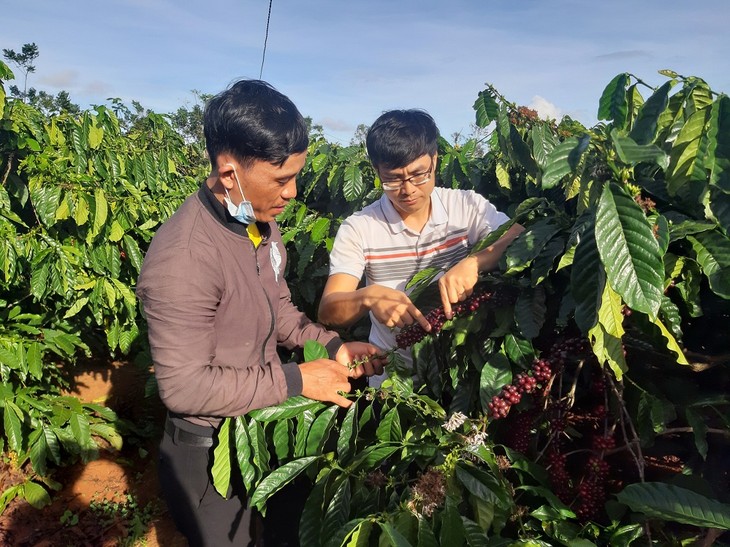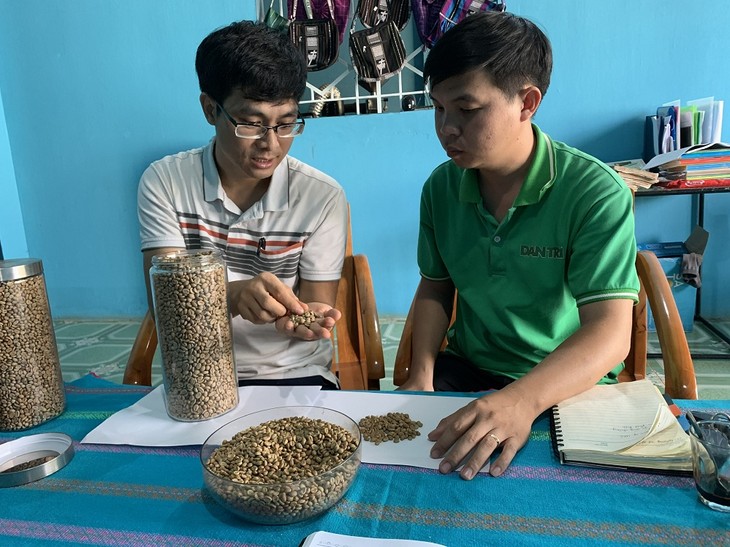(VOVWORLD) - Rapid adaptation to market trends and close coordination with exporters have enabled many farmers in the Central Highlands province of Gia Lai to move away from traditional production toward methods more in line with global health, environment, and export standards.
 Si Mon’s coffee cultivation follows UTZ standards. (Photo: VOV) Si Mon’s coffee cultivation follows UTZ standards. (Photo: VOV) |
Si Mon in Dak Doa district, one of Gia Lai province’s largest coffee growing areas, is harvesting a 1-hectare coffee plantation, even though coffee prices are below 30 US cents per kilo at this time of the year.
Because he complies with the UTZ health and environment standards for safe coffee, Mon can get 37 US cents per kilo.
UTZ was launched in 2002 by a Belgian-Guatemalan coffee grower and a Dutch coffee roaster, with the goal of implementing sustainability on a large scale in the worldwide market. From 2014, UTZ is the largest program for sustainable farming of coffee and cocoa in the world. The UTZ program comprises a reasonable handling of agricultural practices, social and living conditions, farm management, and the environment.
Mon said he and other farmers in his village have been producing UTZ-certified coffee since the 2018-2019 crop.
The UTZ model has completely changed his production methods. Chemical pesticides and fertilizers are only used at certain prescribed times. Herbicides aren’t used at all, and the amount of organic fertilizers and probiotics used to control insect pests have increased.
“In the past, my land was depleted. Now it has more microorganisms. The coffee trees are stronger and yields are more stable. We no longer experience irregular bumper harvests,” said Mon.
Suan, another farmer in Dak Doa, has 1.5 hectares of coffee. He has been producing UTZ-certified coffee since 2018.
Suan recalls that the first crop produced only 1.7 tons of coffee beans per hectare. But productivity has steadily increased. This year, he expects to harvest about 5 tons of coffee beans per hectare.
Suan said the UTZ model produces cleaner coffee, protects growers’ health and the environment by reducing harmful chemicals, stabilizes productivity, and reduces production costs, yielding higher profits.
“Once the coffee trees have adapted to the new cultivation process, we can sell the ripest beans at export prices and sell the rest at normal prices,” he said.
“If we use fertilizer as the model prescribes, the yield will definitely be higher. I’m urging other villagers to adopt the UTZ model to increase their productivity, reduce costs, and ensure safety and sustainability. If they strictly follow the UTZ process, Dak Doa coffee prices will increase.”
 A member of Lam Anh Agricultural and Service Cooperative shares knowledge of UTZ with a farmer. (Photo: VOV) A member of Lam Anh Agricultural and Service Cooperative shares knowledge of UTZ with a farmer. (Photo: VOV) |
Le Huu Anh, Director of the Lam Anh Agricultural and Service Cooperative, said the cooperative has 19 members and 31 affiliated households growing a total of 70 hectares under the UTZ standards.
70% of the cooperative’s members are Bahnar people. This year’s total UTZ-certified coffee yield will be about 200 tons. Anh said the cooperative is working with a coffee exporter so its output will be sold at a predictable price.
“Farmers have responded enthusiastically to the model. Our goal is to produce clean, qualified coffee beans that fetch higher export prices. We are developing Slar Land-branded coffee products, which so far have gotten a good response in the market,” said Anh.
Bui Quang Thoai, Deputy Chairman of Glar commune, said the UTZ model ensures that coffee products have clear traceability and geographical indications.
“The model has taught the farmers when to use pesticides and not to use herbicides that pollute the environment. This produces safer coffee with a much higher value.”